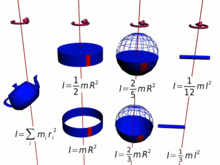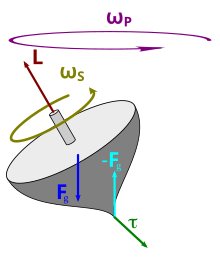Angular momentum
In physics, angular momentum (sometimes called moment of momentum or rotational momentum) is the rotational analog of linear momentum. It is an important physical quantity because it is a conserved quantity – the total angular momentum of a closed system remains constant. Angular momentum has both a direction and a magnitude, and both are conserved. Bicycles and motorcycles, flying discs,[1] rifled bullets, and gyroscopes owe their useful properties to conservation of angular momentum. Conservation of angular momentum is also why hurricanes[2] form spirals and neutron stars have high rotational rates. In general, conservation limits the possible motion of a system, but it does not uniquely determine it.
The three-dimensional angular momentum for a point particle is classically represented as a pseudovector r × p, the cross product of the particle's position vector r (relative to some origin) and its momentum vector; the latter is p = mv in Newtonian mechanics. Unlike linear momentum, angular momentum depends on where this origin is chosen, since the particle's position is measured from it.
Angular momentum is an extensive quantity; that is, the total angular momentum of any composite system is the sum of the angular momenta of its constituent parts. For a continuous rigid body or a fluid, the total angular momentum is the volume integral of angular momentum density (angular momentum per unit volume in the limit as volume shrinks to zero) over the entire body.
Similar to conservation of linear momentum, where it is conserved if there is no external force, angular momentum is conserved if there is no external torque. Torque can be defined as the rate of change of angular momentum, analogous to force. The net external torque on any system is always equal to the total torque on the system; in other words, the sum of all internal torques of any system is always 0 (this is the rotational analogue of Newton's third law of motion). Therefore, for a closed system (where there is no net external torque), the total torque on the system must be 0, which means that the total angular momentum of the system is constant. The change in angular momentum for a particular interaction is called angular impulse, sometimes twirl.[3] Angular impulse is the angular analog of (linear) impulse.
The trivial case of the angular momentum of a body in an orbit is given by
The angular momentum of a uniform rigid sphere rotating around its axis instead is given by



.jpg/440px-Cup_of_Russia_2010_-_Yuko_Kawaguti_(2).jpg)

- Left: "spin" angular momentum S is really orbital angular momentum of the object at every point.
- Right: extrinsic orbital angular momentum L about an axis.
- Top: the moment of inertia tensor I and angular velocity ω (L is not always parallel to ω).[33]
- Bottom: momentum p and its radial position r from the axis. The total angular momentum (spin plus orbital) is J. For a quantum particle the interpretations are different; particle spin does not have the above interpretation.
